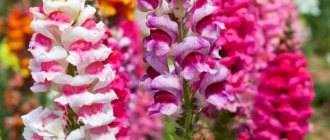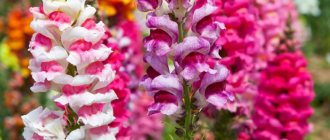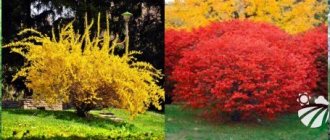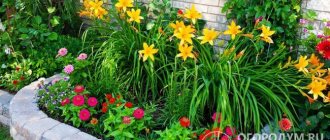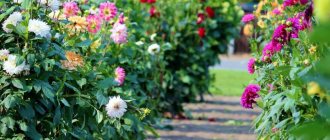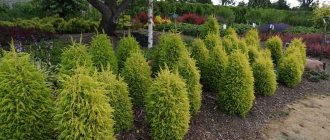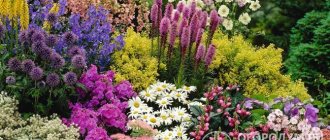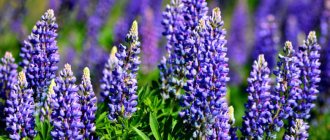The name of this group of plants speaks for itself: they live for one summer. Their development - from sowing in spring to the formation of new seeds in autumn - lasts one growing season. But over their short life, they become a bright decoration of a personal plot and give flower growers a lot of positive emotions. Counters of specialized stores and Internet catalogs offer a huge assortment of different types and varieties of flower and ornamental crops. How to choose annual flowers for a flower bed depending on their height, structure, placement method, when and how to plant - we will tell you in detail in the article.
Bright “suns” in the flowerbed: marigolds and zinnias
Annual plants are divided into true annuals and conditional ones, which by nature are perennial, but are grown in culture as annuals. These are petunia, snapdragon, fragrant tobacco, etc.
Benefits of growing annuals
There are many easy-to-care flowers for landscaping and garden decoration. Most annual flowers for the garden, blooming all summer, delight the eye with their colors until frost. Annuals have their advantages compared to perennials:
- unpretentious annuals that bloom for a long time create new compositions in the garden every year;
- most annual flowers are very bright;
- annual flowers grow quickly and fill uncovered spaces in a flowerbed or mixborder;
- a significant part of unpretentious annual plants belongs to species that produce buds in the summer and before frost;
- One type of beautifully flowering plants can be planted as seedlings to admire their parade from May, and at the same time sown with seeds for later flowering.
Warning! Before sowing the seeds of the unpretentious flowers you like, you need to determine whether the soil is suitable for the crop and what level of light and humidity is needed.
When to plant annuals for seedlings according to the 2022 Lunar calendar
Experienced gardeners have long identified the relationship between gardening and the cycles of the moon. It is believed that there are more and less suitable days for performing certain procedures, and this also applies to growing seedlings. Thus, the timing of sowing annual flowers for seedlings according to the 2022 Lunar calendar:
- Favorable days for the procedure: in January: 1, 10, 11, 15, 16, 19, 20;
- in February: 7, 8, 12, 13, 14, 15;
- in March: 10, 11, 15, 20, 21, 24, 25.
- Unfavorable days: in January: 2, 18th;
- in February: 1, 16;
- in March: 2, 16, 17, 18, 31.
Winter and the first half of spring are the so-called rest period for summer residents and avid gardeners. For many of them, such holidays are a blessing, an opportunity to recuperate and take a break before the new season. But also many gardeners and florists really miss gardening, and growing seedlings is a great opportunity not only to get good and strong seedlings of annual flowers, but also to do what you love without leaving home. An important task is not only the process of planting and growing, but also the choice of crops. I hope you found some options that suit you on this list.
What types of annuals are there?
When planning a flowerbed or mixborder, pay attention to the flowering period of the selected unpretentious plants, as well as their structure: height, spreading, color of leaves and petals.
Separation by timing and duration of flowering
Spectacular garden ensembles are created taking into account the time of the most magnificent flowering. There are species in which flowers are constantly formed throughout the summer, such as cosmos, zinnia, petunias, seed dahlias, purslane, and calendula. Many garden annual flowers that bloom all summer form buds from the beginning of development. And then, stimulated by pruning the shoots, they enter a second abundant wave of flowering at the end of summer, like alyssum, lobelia, iberis, and verbena.
The duration of the riot of colors in the flowerbed is controlled by planting sprouts of the selected crop, which create buds from the end of May and the beginning of summer. Earlier or at the same time, the same unpretentious annual is sown so that it begins to bloom in mid-July. This is how they create continuous flowering of salvia, marigolds, and annual aster, which is often called Callistephus sinensis in stores, according to the new international classification.
Systematization by plant height
For large flower beds and mixed borders, they plan to plant annual flowers that bloom all summer, placing low-growing crops along the edges and taller ones in the middle. Using the same principle, unpretentious flowers are sown for borders or ridges, oblong and spacious flower beds placed near paths, fences, and walls. There are plant species in which different varieties are short and tall: cosmos, marigolds, zinnias, fragrant tobacco.
Height of some unpretentious crops:
- the smallest bushes are found in lobelia, alyssum, purslane, verbena, and tricolor bindweed;
- snapdragons, nasturtiums, dahlias and poppies, eschscholzia, dimorphotheca, gaillardia, coreopsis grow up to 50 cm;
- from 50 to 100 cm, asters, erect marigolds, cosmos, zinnias, cornflowers, gillyflowers, and large-flowered flax grow;
- some varieties of cosmos, castor bean, mallow, sunflower and decorative amaranth reach 1.5 m and higher.
Attention! The following subtleties are taken into account: the bell does not like waterlogging; asters are placed in the sun; morning glory suffers from drafts; purslane is sown in soil with sand.
Classification of annuals by purpose of use
Usually, annual flowers that bloom all summer are chosen for a flower bed, based on some common characteristic: shade, height. Agricultural techniques for growing unpretentious crops are also taken into account.
Landing dates
The optimal timing is calculated depending on the region and method of cultivation. We summarize the recommendations for flower growers in central Russia in the table:
| Growing method | Boarding time | Representatives |
| Seedless | ||
| Early spring sowing | Second half of April | Mattiola, iberis, blue cornflower, eschscholzia, cosmos, calendula, clarkia |
| Late spring | First ten days of May | Marigolds, nasturtium, lavatera, malopa, morning glory, sweet pea, dimorphotheca, acroclinum |
| Podzimny | Late October – early November | Godetia, cornflower, calendula, cosmos, antirrinum (snapdragon), iberis, clarkia |
| Rassadny | ||
| Winter sowing | End of January – February | Evergreen begonia, verbena, lobelia, petunia, Chabot carnation, eustoma, annual delphinium, viola, statice |
| Early spring | March | Ageratum, alyssum, amaranth, asters, verbena, gatsania, Chinese carnation, heliotrope, helichrysum, sweet pea, kochia, gillyflower, lobelia, snapdragon, nemesia, perilla, petunia, salvia, sweet tobacco, Drummond's phlox, cineraria |
| Mid-spring | Mid April | Marigolds, zinnia, amaranth, dahlias, coleus, celosia, chrysanthemums |
In the northern regions, Siberia, and the Urals, sowing seeds for seedlings and, accordingly, planting in open ground are shifted to a later date
The most beautiful annuals that bloom all summer
Having familiarized yourself with the selection of beautifully flowering and long-flowering annuals, with their photos and names, be sure to pay attention to the conditions of their cultivation. Among the most expressive flowers that capture the eye for a long time are petunia, lobelia, begonia and cosmos, which create buds throughout the summer, ageratum and poppies, which bloom buds for a shorter period. They also add unpretentious but bright flowers: zinnia, dimorphotheca, tricolor low-growing bindweed, lavatera and many others. Almost all crops are hardy, sun-loving, and drought-resistant. They prefer loose soil, light loams and sandy loams, but with mineral fertilizers. Standing apart is the moisture-loving begonia, which develops well in shady areas, but can burn out in the southern sun. Shade-tolerant plants also include cosmos and lobelia, which bloom equally well in diffuse shade and in the sun.
Catharanthus
Lobelia
Dimorphotheca
Bindweed tricolor
Petunia
Nemophila Penny Black
The unusually delicate and attractive flowers of the guest from North America, nemophila, are still a rarity for our flower beds and rock gardens. It has pubescent leaves and stems up to 30 cm in length, which spread along the ground.
The flowers are similar to our forget-me-nots; they are white with purple spots, light blue, dark purple with a white border. The latter belong to the Penny Black variety.
They can be planted along paths, in borders and rock gardens. However, nemophiles can also decorate small patios, balconies and window sills. You can also grow them in containers.
Nemophiles are unpretentious in care, they have practically no enemies among insects, but they are dangerous from slugs, which often attack plants. American forget-me-nots easily tolerate frost, so you can sow seeds in open ground from late March to June. But it will not be possible to grow a flower through seedlings, because... he cannot tolerate transplantation.
The plant does not like heat, for this reason it should be placed in shaded areas and the ground should be mulched well.
Low-growing annuals that bloom all summer
There is a large group of crops that bloom low above the ground: matthiola, nemophila, low-growing and thin-leaved marigolds, alyssum, lobularia, petunia, lobelia, begonia, dwarf hybrid dahlias, tricolor bindweed, which is sometimes sold under the name convolvulus. Growing unpretentious low flowers that grow to a height of 15-30 cm has its own subtleties:
- when planting such plants in a flowerbed, take into account that dense placement can provoke stretching of the stems and a smaller number of buds;
- by placing some low plants in the shade, they also get elongated stems with scant bud production;
- Also, low-growing annual flowers that bloom all summer should not be fed with organic matter and large amounts of nitrogen preparations;
- it is better to use special mineral fertilizers that promote the formation of buds;
- Often, caring for low-growing, unpretentious plants includes pinching the tops so that side shoots with buds form.
Begonia
Nemophila
Marigold thin-leaved
Mattiola
Dwarf dahlias
Phlox
Annual phloxes will delight you not only with ease of care, but also with an abundance of colors. In addition, with proper agricultural technology, they bloom from June to September.
Phlox seeds are sown for seedlings in March, ventilated every day and condensation is removed. They emerge on the tenth day, and in the 2-leaf phase they are pinched and protected from direct sunlight. Before planting in the ground (in May), the seedlings need to be fed twice with complex mineral fertilizer. Phloxes grow well, so leave at least 30 cm between seedlings. Three times a season, feed them with a solution of nitrophoska (20 g per bucket of water), loosen them, but do not over-moisten them. Timely removal of dried flowers will prolong the flowering period.
Decorative deciduous annuals
Among the annual spectacular plants with charming leaves are:
- bright green lacy beauty kohiya;
- tall castor bean with large dark green or burgundy leaves;
- luxurious silver cineraria;
- coleus with multi-colored patterns on the leaves;
- decorative amaranth, surprising with its lush green mass and strange, long burgundy inflorescences.
Advice! Most crops with showy leaves are placed in the background of the mixborder because they rise above the rest of the flowers.
Amaranth
Coleus
Cineraria
Kochia
Castor bean
Annual climbing flowers blooming all summer
In the climate of the central zone of the country, several types of unpretentious climbing annuals are grown that bloom all summer: kobeya, morning glory, dolichos or hyacinth beans, sweet peas, climbing nasturtium, black beans, decorative red-flowered beans or Turkish beans. Climbing annuals are watered abundantly in the summer during the initial growth period. All plants climb independently on supports, reaching a height of up to 2.5-3 m. Climbing unpretentious flowers are provided with a sunny place, loose, light soil with a neutral acid reaction.
Kobeya
morning glory
Dolichos
Sweet pea
Nasturtium
Unpretentious annuals that bloom all summer
The most undemanding to the conditions are the well-known zinnia, cosmos, lavatera, eschscholzia, helenium, gaillardia, annual coreopsis, alyssum, nasturtium, calendula, mirabilis, salvia, datura, cornflowers. This group is quite numerous and widespread. You can look at long-blooming annual flowers, their photos and names, choose your favorite ones, sow them in sun-warmed soil and not worry about the flower bed. Plants only need watering once a week. Most of the crops are drought-resistant and shade-tolerant. The soil in the flowerbed should be loose, light, and neutral in acidity. Flowers are freed from weeds and wilted baskets that spoil the appearance of the flower bed are removed.
Comment! Unpretentious annuals are fed with special fertilizers for flowers in the bud creation phase.
Zinnia
Cosmea
Lavatera
Helenium
Mirabilis
Adonis
This poisonous flower has been known since the times of ancient Greece, but it began to be actively grown in gardens only in the 17th century. Its seeds quickly lose their viability, so it is advisable to sow them in the fall, immediately after harvest. Most varieties of Adonis are characterized by yellow flowers, although according to legend, the blood of Aphrodite's lover colored them red.
After the adonis shoots emerge, they need to be thinned out, watered and loosened frequently. They bloom best in light soils, in areas where the sun shines in the morning and shade reigns in the afternoon. By the way, thanks to its natural toxicity, adonis is protected from harmful insects and resistant to diseases.
Dried flowers
Among the annuals in the country that bloom all summer, drought-resistant crops are sometimes planted in the very sun. They are also called immortelle flowers, because unpretentious flowers remain dry in bouquets without water for a relatively long time, without losing the colors of their corolla. Helichrysum petals have multi-colored shades - from white and yellow to pink and red. Dried flowers have colorful, hard petals and stems from 20 to 80 cm.
To form large, rich inflorescences, the seeds are sown in fertile soil in May and fed with mullein or rabbit droppings. The soil is kept loose, weeds are removed so that the unpretentious plant develops freely. It is better to propagate low-growing species by seedlings, starting sowing in February and March.
Helichrysum
Helipterum
Rodanthe
Xeranthemum
Kermek
Petunia
Red, red-white, red-black, purple, scarlet - there are countless colors, like varieties of petunias. When buying its seeds, it is simply impossible to stop. It is no coincidence that this flower adorns city parks and flower beds - it grows bravely even in the most unfavorable conditions.
Petunias are sown for seedlings at the end of February and after the emergence of seedlings they begin to actively add light. The tray with the crops should always be very humid, but they should be ventilated every day, and the film or glass covering the tray should be wiped. In the phase of 3-4 leaves, the seedlings dive, and after a week they begin to feed with nitrophoska, Kemira or Mortar according to the instructions. Petunia is planted in the ground after the threat of return frosts has passed, in a sunny, well-fertilized place. Petunias need to be fed and watered very often, and then be sure to loosen them.
Border annuals that bloom all summer
For borders, low, long-flowering annuals are used, as in the photo. Unpretentious plants are sown that decorate the paths most of the summer and even in the fall. They also grow or buy seedlings. Each year you can change the colors of the same crop or place different types. Plants are selected according to their requirements for lighting, soil and humidity. The group of low border flowers is numerous, it also includes decorative foliage representatives: alyssum, petunia, cineraria, coleus, salvia, verbena, low-growing marigolds, cellosia, ageratum, dwarf dahlias, lobularia, nasturtium, catharanthus and others.
Important! Planting border annuals on the border of mixed borders, lawns, and near hedges gives the design the finishing touch and emphasizes the smooth transition from tall forms to the surface.
Verbena
Lobularia
Marigolds are low growing
Iberis
Tradescantia zebrina
Calendula
This plant, beloved by summer residents, reaches out to the sun with its yellowish-red heads all summer long. They grow field and medicinal calendula, lovingly calling it marigold. Medicinal herbs are used for food and for preparing potions.
Calendula flowers are sensitive to light. The petals cover the core when night falls or summer weather promises a sharp cooling.
Carpet or ground cover annuals
It is easiest to create a beautiful composition for the summer from low ground cover, brightly flowering plants or crops with expressive leaves, such as coleus, chlorophytum crested, ornamental cabbage and cineraria. Carpet flowers are used to form fashionable ornamental compositions that will become the highlight of the area in summer. Lobularia, iberis, ageratum, catharanthus, marigolds, alyssum, petunia, lobelia, nemophila, purslane, climbing tradescantia grow abundantly and form buds all summer long on soils fertilized with minerals.
Ageratum
Purslane
Diascia
Malcolmia
Eschszolzia
Antirrinum
Another flower with a long history was given to Hercules for his victory over the Nemean lion and is known to the world as snapdragon. It has been cultivated in gardens for more than five hundred years, and during this time a thousand varieties have been created from one plant.
In warm climates, snapdragons can be sown directly into the ground, but in the middle zone it is better to plant them as seedlings in March. Shoots appear in a couple of weeks, and grow even more slowly. The main thing is not to forget to regularly moisten the sprouts and cover them from direct sunlight, and to prick them in the phase of a pair of true leaves. Antirrinum is planted in the ground in early June, in well-drained areas protected from the wind. It is advisable to tie bushes of tall varieties to a support, and all snapdragons without exception should be fed twice a season (after planting and before flowering) with complex mineral fertilizers for flowering plants.
Potted annual flowers
Photos and names of annuals blooming all summer in pots show their beauty and charm. Often, for such especially beloved and expensive crops, sun-loving hybrid petunias and their “relatives” with small flowers - calibrachoa - are chosen. The group includes begonias, calceolarias and indoor balsams, which are placed in the shade; fuchsia, pelargonium. Crops are watered at the roots and fed with flower fertilizers.
